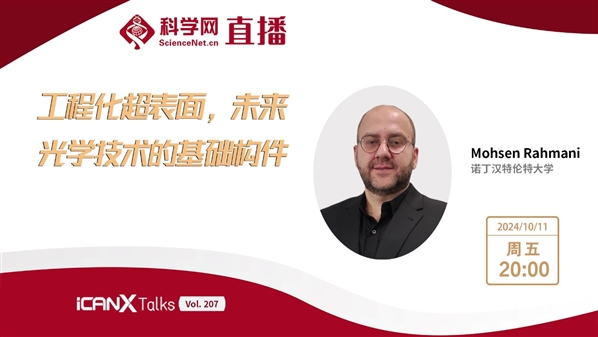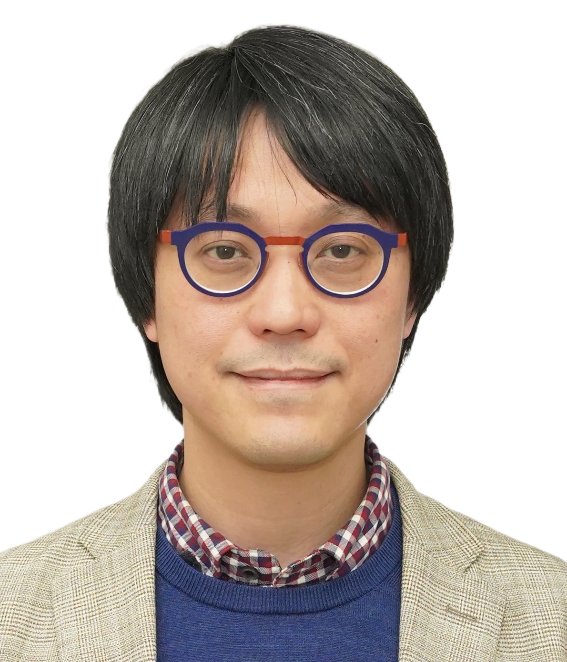|
|
|
|
|
诺丁汉特伦特大学教授讲述工程化超表面,未来光学技术的基础构件 |
|
|

直播时间:2024年10月11日(周五)20:00-21:30
直播平台:

科学网APP
https://weibo.com/l/wblive/p/show/1022:2321325088295842611355
(科学网微博直播间链接)

科学网微博

科学网视频号
北京时间2024年10月11日晚八点,iCANX Talks 第207期邀请到了诺丁汉特伦特大学Mohsen Rahmani作为主讲嘉宾,安大略理工大学Amirkianoosh Kiani,北海道大学Yoshito Y. Tanaka两位教授也将进行分享!厦门大学Minghui Hong、北京大学Haixia Zhang两位教授担任研讨嘉宾,澳大利亚国立大学 Lan Fu教授担任主持人。
这将是一场汇聚顶尖学者的盛会,共同探讨前沿科技与学术挑战!更多精彩,敬请期待!
【嘉宾介绍】

Mohsen Rahmani
诺丁汉特伦特大学
Engineered meta-surfaces, building blocks of tomorrow’s optical technologies
【Abstract】
Recent advancements in nanofabrications, characterisations, and computer modelling have allowed the generation of arrays of engineered nanoparticles, called meta-surfaces, that extraordinarily control light characteristics. They can reproduce the functions of bulky geometrical optics such as lenses, mirrors or filters. Alongside that, occasionally, metasurfaces can offer some functionalities that are not achievable by geometrical Optics, such as tunability. Such advances have led to revolutionary applications in several fields, including but not limited to meta-lenses, polarisation converters, nano-sensors, and holograms. In this talk, I will briefly review the research activities of the Advanced Optics and Photonics Group at Nottingham Trent University on light-matter manipulation for real-life applications. I will discuss how engineering metallic, dielectric, and semiconductor nanoparticles enable us to control the light intensity, frequency, and propagation direction. I will demonstrate how such controls can help us to generate optical nano-switches with switching time faster than the human eye’s response. Also, I will explain how we can engineer nanoparticles to convert images from the near-infrared region, invisible to human eyes, to the visible region. Finally, I will show our latest results on how nanostructures can help monitor individual proteins over time. These are tiny examples, among many other technologies that are being developed in the community, of why many people consider photonics at the heart of cutting-edge technologies in the 21st century.
最近在纳米制造、表征和计算机建模方面的进展,使得我们可以生成一种称为超表面(meta-surfaces)的工程纳米颗粒阵列,这些超表面能够非凡地控制光的特性。它们能够复制体积庞大几何光学元件的功能,如透镜、镜子或滤光片。除此之外,有时超表面能够提供一些几何光学无法实现的功能,比如可调谐性。这些进展在包括但不限于超透镜、偏振转换器、纳米传感器和全息图等多个领域带来了革命性的应用。在本次演讲中,我将简要回顾诺丁汉特伦特大学高级光学与光子学组在光物质操控方面的研究活动,这些研究活动针对现实生活的应用。我将讨论如何通过设计金属、介质和半导体纳米颗粒来控制光的强度、频率和传播方向。我将展示这种控制如何帮助我们生成比人眼反应时间更快的光学纳米开关。此外,我还将解释我们如何设计纳米颗粒,将近红外区域的图像(肉眼不可见)转换到可见区域。最后,我将展示我们在如何利用纳米结构随时间监测单个蛋白质方面的最新成果。这些只是众多正在开发的技术中的一小部分例子,许多人认为光子学是21世纪尖端技术的核心。
【BIOGRAPHY】
Prof. Mohsen Rahmani is a professor of optics and photonics and the leader of the advanced optics and optics laboratory at Nottingham Trent University (NTU), in the UK. He obtained his PhD from the National University of Singapore in 2013, followed by a postdoc fellowship at Imperial College London and the Australian Research Council Early Career Fellowship at the Australian National University. In 2020, he joined NTU via the prestigious Royal Society Wolfson Fellowship. Shortly after moving to the UK, he was also awarded the UK Research and Innovation Future Leaders Fellowship. His research activities span over light-matter interactions with nanometre-scale particles for applications in flat optics, near-infrared imaging, bio-sensing, and reconfigurable optics. He has received several prestigious awards and prizes, including the Australian Eureka Prize (Australian Oscar of Science), the Early Career Medal from the International Union of Pure and Applied Physics, and the Australian Optical Society Geoff Opat Award. Professor Rahmani has delivered 40+ invited talks, seminars and keynotes at international conferences and has published more than 80 peer-reviewed journal papers (H-index=43). He is the past chair of the IEEE Nanotechnology Chapter across the UK and Ireland section and a distinguished lecturer for IEEE Nanotechnology Council 2024.
Mohsen Rahmani教授是英国诺丁汉特伦特大学(NTU)的光学与光子学教授,同时也是高级光学与光子学实验室的负责人。他于2013年在新加坡国立大学获得博士学位,随后在伦敦帝国理工学院从事博士后研究,并在澳大利亚国立大学获得澳大利亚研究理事会早期职业研究员奖学金。2020年,他通过享有盛誉的皇家学会沃尔夫森奖学金加入了NTU。移居英国后不久,他还被授予英国研究与创新未来领袖奖学金。他的研究活动涵盖了与纳米尺度颗粒的光物质相互作用,应用于平面光学、近红外成像、生物传感和可重构光学等领域。他获得了许多著名奖项和奖金,包括澳大利亚尤里卡奖(澳大利亚科学奥斯卡)、国际纯粹与应用物理联合会早期职业奖章,以及澳大利亚光学学会Geoff Opat奖。Rahmani教授已在国际会议上发表了40多个邀请演讲、研讨会和主题报告,并发表了80多篇同行评审的期刊论文(H指数=43)。他是IEEE英国和爱尔兰分会纳米技术分会的前任主席,也是IEEE纳米技术委员会2024年的杰出讲师。

Amirkianoosh Kiani
安大略理工大学
Semiconductor Nanowires for Optoelectronics Applications
【ABSTRACT】
The Ultra-short Laser Pulse for In-situ Nanostructure Generation (ULPING) technique represents a significant advancement in the fabrication of nano energy materials for energy storage devices. This innovative method utilizes ultra-short laser pulses to create intricate 3D nanonetworks, enhancing the electrochemical performance and longevity of energy storage systems, including supercapacitors. By precisely controlling surface morphology and nanostructure formation, ULPING improves the efficiency and capacity of these devices, offering a versatile and effective approach to developing high-performance materials essential for next-generation energy solutions. This presentation will delve into the mechanisms and applications of ULPING, showcasing its potential to revolutionize the field of energy storage.
用于原位纳米结构生成的超短激光脉冲(ULPING)技术在储能设备的纳米能源材料制造方面取得了重大进展。这种创新方法利用超短激光脉冲创建复杂的3D纳米网络,增强了包括超级电容器在内的储能系统的电化学性能和寿命。通过精确控制表面形态和纳米结构的形成,ULPING提高了这些设备的效率和容量,为开发下一代能源解决方案所必需的高性能材料提供了一种多功能且有效的方法。本次演讲将深入探讨ULPING的机制和应用,展示其在能源存储领域革命化的潜力。
【BIOGRAPHY】
Dr. Amirkianoosh Kiani is an esteemed Associate Professor in the Department of Mechanical and Manufacturing Engineering at Ontario Tech University (ON, Canada), where he also serves as the Graduate Program Director. With a prolific career in advanced materials research, Dr. Kiani has made significant contributions to the fields of nano fabrication and laser materials processing.vOne of Dr. Kianis most notable achievements is the development of a novel technique known as Ultra-short Laser Pulse for In-situ Nanostructure Generation (ULPING). This groundbreaking method leverages ultra-short laser pulses to fabricate complex 3D nanonetworks and semiconductor materials, offering a versatile and efficient approach to materials synthesis. The ULPING technique stands out for its ability to create high-performance energy materials and electrode structures, which are crucial for various applications, including supercapacitors and other energy storage devices. Dr. Kiani’s research has demonstrated that the ULPING method can significantly enhance the electrochemical performance of materials by optimizing surface morphology and nanostructure formation. This innovation not only improves the efficiency and lifespan of energy storage systems but also opens new avenues for the fabrication of advanced 3D nanonetwork semiconductors. These semiconductors are pivotal in the development of next-generation electronic devices, biosensing technologies, and other high-tech applications. Dr. Kiani’s innovative research has been widely presented at international conferences and published in several reputable journals. His contributions to the scientific community have been recognized with funding from prestigious organizations such as the Ontario Centres of Excellence and the Natural Sciences and Engineering Research Council of Canada (NSERC). With a commitment to pushing the boundaries of materials science and engineering, Dr. Kiani continues to inspire and lead in the quest for more efficient, sustainable, and high-performing nanomaterials.
Amirkianoosh Kiani博士是加拿大安大略理工大学(ON,加拿大)机械与制造工程系的一位受人尊敬的副教授,同时他也担任研究生项目主任。Kiani博士在先进材料研究领域有着丰富的职业生涯,在纳米制造和激光材料加工领域做出了重要贡献。Kiani博士最引人注目的成就之一是开发了一种名为用于原位纳米结构生成的超短激光脉冲(ULPING)的新技术。这种开创性的方法利用超短激光脉冲制造复杂的3D纳米网络和半导体材料,为材料合成提供了一种多功能且高效的方法。ULPING技术以其能够创建高性能能源材料和电极结构而脱颖而出,这对于包括超级电容器在内的各种应用至关重要。Kiani博士的研究表明,通过优化表面形态和纳米结构的形成,ULPING方法可以显著提高材料的电化学性能。这一创新不仅提高了储能系统的效率和寿命,还为制造先进的3D纳米网络半导体开辟了新途径。这些半导体在下一代电子设备、生物传感技术和其他高科技应用的发展中起着关键作用。Kiani博士的创新研究已在国际会议上广泛展示,并在多个知名期刊上发表。他对科学界的贡献得到了安大略卓越中心和加拿大自然科学与工程研究理事会(NSERC)等知名组织的资助。Kiani博士致力于推动材料科学与工程的边界,继续在寻求更高效、可持续和高性能纳米材料的道路上激励和领导。

Yoshito Y. Tanaka
北海道大学
Light-Powered Nanoactuators: Controlling Light Momentum with Metallic Optical Nanoelements
【ABSTRACT】
Optical forces resulting from the momentum transfer of light in light-matter interactions are powerful tools for actuating micromachines and hold great potential for miniaturization and simplification of lab-on-a-chip systems. However, the conventional approaches using optical tweezers, which won the 2018 Nobel Prize in Physics, require focusing and steering of an incident laser beam with bulk optics to control the light momentum and optical force, resulting in a bottleneck in the integration and implementation of the optically actuated micromachines. In this presentation, I will describe nanoscale metallic optical elements such as nanolenses and nanomirrors, which control light momentum and optical force at the nanoscale. I will introduce how these optical nanoelements are designed and how they can be applied to nanoactuators and how they remove the limitation of light diffraction and the need for focusing and steering of the light beams. Finally, I will briefly discuss our ongoing study on how actuators based on the optical nanoelements can acquire autonomy.
光与物质相互作用中产生的光的动量转移导致的光学力是驱动微电机的强大工具,对芯片实验室系统的微型化和简化具有巨大潜力。然而,传统的光学镊子方法,该方法赢得了2018年诺贝尔物理学奖,需要使用体积光学聚焦和操纵入射激光束以控制光动量和光学力,这在光学驱动微电机的集成和实施中造成了瓶颈。在本次演讲中,我将描述纳米尺度的金属光学元件,如纳米透镜和纳米镜,它们在纳米尺度上控制光动量和光学力。我将介绍这些光学纳米元件是如何设计的,以及它们如何应用于纳米执行器,以及它们如何消除光衍射的限制和对光束聚焦和操纵的需求。最后,我将简要讨论基于光学纳米元件的执行器如何获得自主性。
【BIOGRAPHY】
Dr. Yoshito Tanaka is a Professor in the Department of Photonics and Optical Science and Head of the Nanosystem Optical Manipulation Group at Research Institute for Electric Science, Hokkaido University, Japan. He received his Ph.D. from Osaka University in 2009 for his work on optical manipulations of nanoparticles such as J-aggregates, polymers, and metal nanoparticles using a focused laser beam (Optical Tweezers). Prior to his present position, which he has held since 2023, he started his career as a Postdoctoral Researcher at Hokkaido University (2009), held a prestigious research fellowship for young scientists by the Japan Society for the Promotion of Science (JSPS) at Imperial College London (2013) and worked as a Specially Assigned Assistant Professor at Kwansei Gakuin University (2014) and then an Assistant Professor at the University of Tokyo. He was also appointed as a PRESTO/JST researcher during 2015–2019. After his Ph.D., his has focused on understanding and controlling the interactions between artificial nanostructures and light from the viewpoint of light momentum and optical force, and has created novel optical nanomanipulations and nanoactuators that overcome the limitations and constraints of optical tweezers. In recognition of such original and unique research, he has received several prestigious awards, including the Young Scientist Award of the Minister of Education, Culture, Sports, Science and Technology in 2018, the Japan Laser Society Award in 2020, and the Optical Paper Award in 2021.
Yoshito Tanaka博士是日本北海道大学光子学与光学科学系教授,纳米系统光学操纵研究小组负责人。他于2009年在大阪大学获得博士学位,因其使用聚焦激光束(光学镊子)对J-聚集体、聚合物和金属纳米颗粒等纳米颗粒进行光学操纵的研究而获得博士学位。在自2023年起担任现职之前,他于2009年开始在北海道大学担任博士后研究员,2013年在英国帝国理工学院获得日本学术振兴会(JSPS)为年轻科学家设立的杰出研究奖学金,并在关西大学担任特别指派助理教授(2014年),随后在东京大学担任助理教授。他还于2015-2019年被任命为PRESTO/JST研究员。在获得博士学位后,他专注于从光动量和光学力的角度理解和控制人造纳米结构与光之间的相互作用,并创造了克服光学镊子限制和约束的新型光学纳米操纵和纳米执行器。由于这些原创和独特的研究,他获得了多项著名奖项,包括2018年教育、文化、体育、科学和技术大臣颁发的年轻科学家奖、2020年日本激光学会奖和2021年光学论文奖。
特别声明:本文转载仅仅是出于传播信息的需要,并不意味着代表本网站观点或证实其内容的真实性;如其他媒体、网站或个人从本网站转载使用,须保留本网站注明的“来源”,并自负版权等法律责任;作者如果不希望被转载或者联系转载稿费等事宜,请与我们接洽。